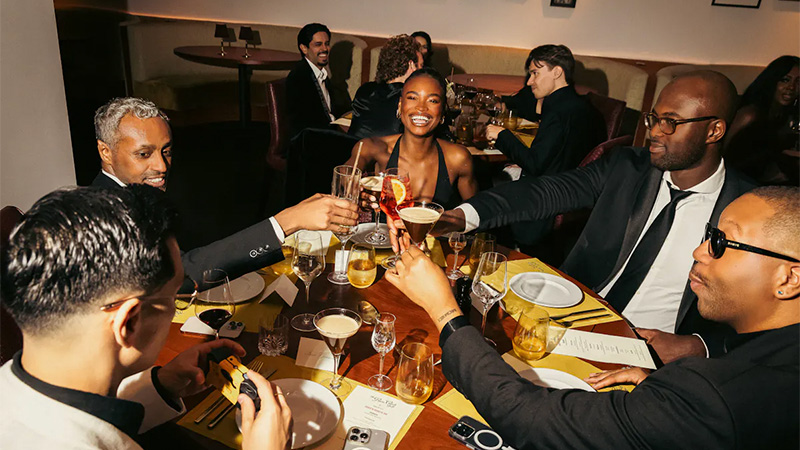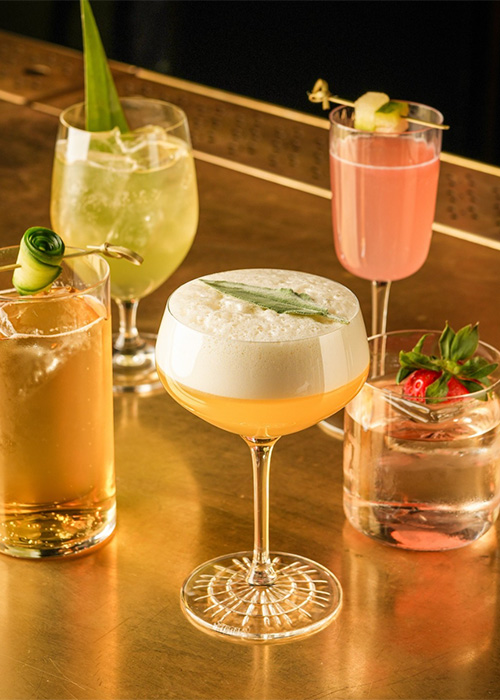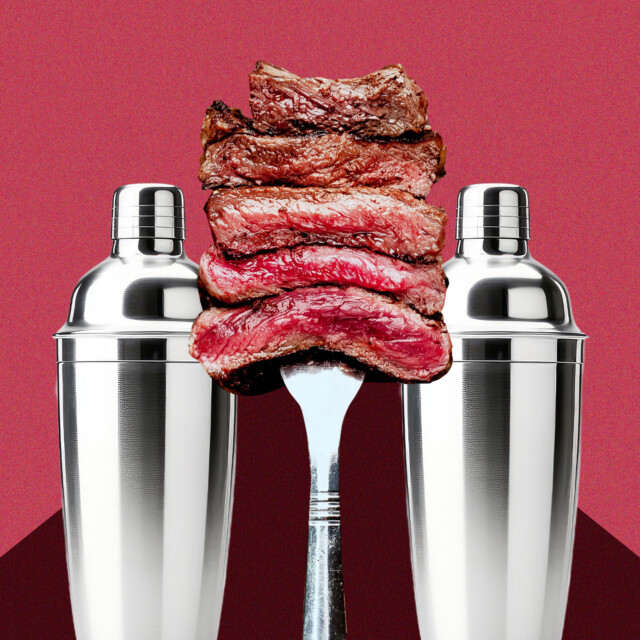There’s a new steakhouse in New York. It’s called — in rather too-on-the-nose fashion — Bourbon Steak, and it’s part of a chain of seven such restaurants from noted San Francisco chef Michael Mina. Bourbon Steak is one example of a new breed of restaurant. Some call them modern steakhouses and others term them contemporary steakhouses. The general idea is that they all take the classic steakhouse model and give it an upgrade in terms of style and culinary touches.
That said, any customer who takes a single glance at the Bourbon Steak menu would make no mistake as to the kind of eating establishment they were in. There are the oysters and the shrimp cocktail; the Caesar and wedge salads; and the various cuts of steak, from ribeye to porterhouse to New York strip.
However, if that menu-browsing patron began with the cocktail list, there might be some confusion. The one at Bourbon Steak begins with a Bee’s Knees and continues with a Pisco Punch and Sherry Cobbler. There’s an original mezcal concoction named Fire Walk With Me, after the David Lynch film. There is the expected Martini, but it’s made with sherry; and the predictable Old Fashioned, but its base is Rare Character Single Barrel Bourbon, an expensive sourced whiskey.
Other new and newish steakhouses that have similarly ambitious cocktail programs include Hawksmoor, a chain born in London in 2006 that opened a New York branch in 2021 and a Chicago location this year; Cote, the Korean steakhouse group first opened by Simon Kim in Manhattan in 2017; the reimagined Brooklyn landmark Gage & Tollner; Quality Meats, part of Alan and Michael Stillman’s empires of restaurants; and The Press Club Grill, which opened in Herald Square last year.

Incubators of Cocktail Culture
From the repeal of Prohibition until the turn of the 21st century, old-school steakhouses were dependable incubators of cocktail culture, even as other types of restaurants gave up on mixed drinks. But the array of adult refreshments you could get at a steakhouse was limited, usually including Martinis, Manhattans, Old Fashioneds, and a handful of other classics.
In the last decade or so, however, the trajectories of the modern cocktail revival and the modern steakhouse movement have aligned. The result is perhaps the first new American steakhouses in a century and a half to serve the kind of drinks that steak eaters of pre-Prohibition times tossed back.
“There’d never been anyone in my role before,” says Michael Lay, who was brought in as the Mina Group’s beverage director five years ago. “No one was overseeing the beverages in the company as a whole. Many of the cocktail menus were left to run themselves. I’ve spent five years trying to create harmony and synergy for the restaurants,” he adds.
It was a role Lay happily took on. That’s because — and this is the case with most modern cocktail bartenders — he didn’t need to be coaxed into a false affection for classic steakhouses. “I absolutely love old-school steakhouses,” he says. “That is my favorite dining experience.”
“We stay true to the classic steakhouse aesthetic, but with a slightly modernized version of the drinks.”
Like Lay, the beverage directors at modern steakhouses approach their assignment with a healthy respect for the genre’s history. They start by tackling the key steakhouse cocktails and elevating them slightly.
“I wanted to harken to the steakhouse classics — Martinis, Manhattans, Old Fashioneds — all those things that you want to start your meal with,” says Max Green, spirits and bar director of the Hospitality Department, a restaurant group that includes The Press Club Grill. “The first menu was classics.” The question that followed that decision, according to Green, was, “How do we make the drinks our own?”
The answer came in small touches. The Press Club Grill’s Gibson, called Page Turner, has house-made onions and a house-made honey tincture. The punched-up Old Fashioned, called City Desk, is made with a mix of Scotch and brandy.

The same philosophy prevails at Quality Meats, where creative director (formerly bar director) Bryan Schneider, supervises the drinks menu. The list is only seven drinks long, each cocktail a recognizable classic. But every item bears a twist that draws on modern mixology techniques. The Nitro Negroni is on tap and the Cherry Cola Manhattan is made with bourbon, sherry, and a cola bitters blend.
“We stay true to the classic steakhouse aesthetic, but with a slightly modernized version of the drinks,” says Schneider.
A big part of the modern cocktail makeover at new steakhouses is batched drinks. At old-school joints, every Martini is made to order. At the newer places, the house Martini is, more likely than not, batched, pre-chilled, and ready to pour.
“Freezer Martinis are more acceptable now,” says Green, who has four or five freezer cocktails at The Press Club Grill. “You can really build cocktails that have small measures. With that, there’s a lot more depth of flavor. That’s the cocktail-bar influence.”
Ask the bar directors at these restaurants how the steakhouse bar reached this point of maturity and the first name that comes up is Hawksmoor. The London restaurant had a fully formed cocktail program at its inception, when Nick Strangeway, one of the biggest names in the London cocktail revival, was in charge. It’s been that way ever since.

“I thought that was a great example of what a modern steakhouse could be,” says Lay.
There’s a certain irony to that admiration, however, since, according to Liam Davy, Hawksmoor’s head of bars, the original London locations took most of their signals from American steakhouses.
“We were doing it in London, which had zero experience of quality drinks in restaurants or steakhouses until the 2010s,” says Davy. “We took a lot of inspiration from the U.S. when we started in the U.K.”
“Walking into a steakhouse, I always want a Martini to start. I think it’s important to honor those traditions.”
Davy says that opening Hawksmoor’s first U.S. location, in Manhattan, presented a particular challenge when it came to the bar. Unlike London patrons, who required some guidance through the cocktail list, American diners tend to belly up to the bar with an order already on their lips.
“Day one, people came in and knew exactly what they wanted,” says Davy. “New Yorkers know what they like and we need to deliver it.” Davy’s job, as he sees it, is to augment those existing preferences with a solid list of unusual and original cocktails. “We get a lot of people from column A and some from column B — people who want new cocktails and people who just want a dry Martini.”
Modern steakhouse bar directors share a lot with both types of customer. They are, of course, schooled in modern mixology and are advocates of original drinks. But when they visit a steakhouse they don’t work at, they most resemble the sort of hidebound traditionalists who have been frequenting American red-meat joints for decades.
“Walking into a steakhouse, I always want a Martini to start,” says Sondre Kasin, director of bars at Cote. “I think it’s important to honor those traditions.”
